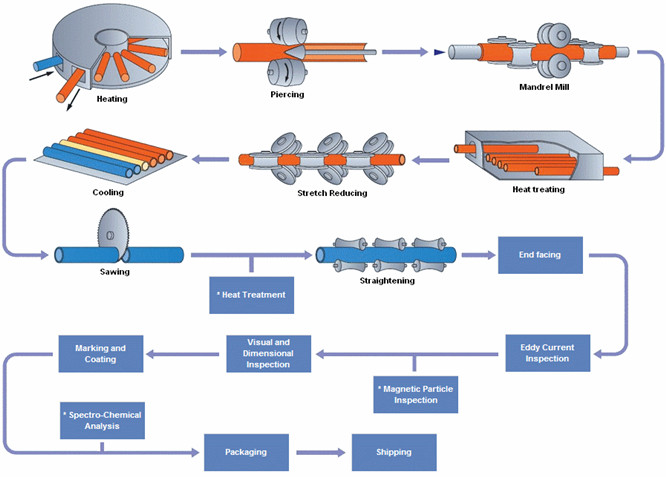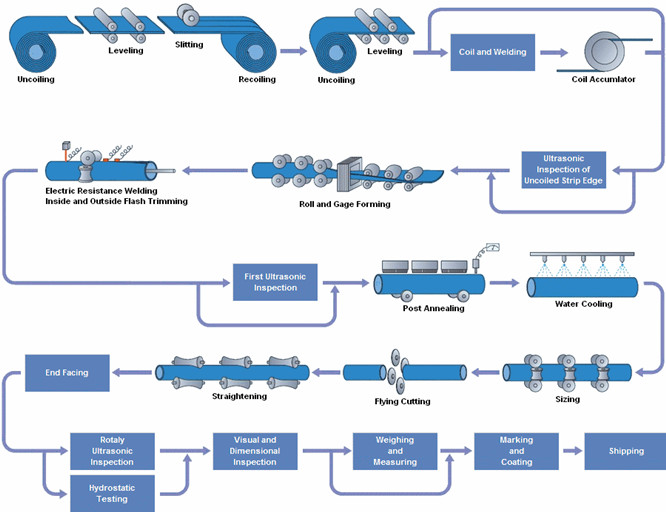Manufacturing processes of steel pipe
Steel pipe is long, hollow tube that is used for a variety of purposes. They are produced by two distinct methods which result in either a welded or seamless pipe.
Design:
There are two types of steel pipe, one is seamless and another has a single welded seam along its length. Both have different uses. Seamless tubes are typically more light weight, and have thinner walls. They are used for bicycles and transporting liquids. Seamed tubes are heavier and more rigid. The have a better consistency and are typically straighter. They are used for things such as gas transportation, electrical conduit and plumbing. Typically, they are used in instances when the pipe is not put under a high degree of stress.
Certain pipe characteristics can be controlled during production. For example, the diameter of the pipe is often modified depending how it will be used. The diameter can range from tiny pipes used to make hypodermic needles, to large pipes used to transport gas throughout a city. The wall thickness of the pipe can also be controlled. Often the type of steel will also have an impact on pipe's the strength and flexibility. Other controllable characteristics include length, coating material, and end finish.
Raw Materials:
The primary raw material in pipe production is steel. Steel is made up of primarily iron. Other metals that may be present in the alloy include aluminum, manganese, titanium, tungsten, vanadium, and zirconium. Some finishing materials are sometimes used during production. For example, paint may be
Seamless pipe is manufactured using a process that heats and molds a solid billet into a cylindrical shape and then rolls it until it is stretched and hollowed. Since the hollowed center is irregularly shaped, a bullet-shaped piercer point is pushed through the middle of the billet as it is being rolled.
Seamless pipe is manufactured using a process that heats and molds a solid billet into a cylindrical shape and then rolls it until it is stretched and hollowed. Since the hollowed center is irregularly shaped, a bullet-shaped piercer point is pushed through the middle of the billet as it is being rolled.
used if the pipe is coated. Typically, a light amount of oil is applied to steel pipes at the end of the production line. This helps protect the pipe. While it is not actually a part of the finished product, sulfuric acid is used in one manufacturing step to clean the pipe.

seamless pipe manufacturing process involves the following steps:
1. Transformation of raw materials into steel bars (Electric arc furnace, ladle furnace, vacuum degassing and continuous casting processes)
2. Transformation of steel bars into mother pipe, which is manufactured in different types of rolling mills
Each product is manufactured in accordance with customer specifications, including heat treatment for more demanding applications. Seamless pipes are threaded and undergo non-destructive testing before delivery to the customer.
Welded wipe manufacturing process involves three types of welding processes:
1. Electric Resistance Welding: During ERW, a high frequency electrical current is transmitted to the material by means of copper sliding contacts so that the abutting edges initiate fusion as they come into contact.
2. Longitudinal Submerged Arc Welding: In LSAW, the butt joint of the pipe is welded in at least two phases, one of which is on the inside of the pipe. The welds are made by heating with an electrode arc between the bare metal electrodes. Pressure is not used. Filler metal for the welds is obtained from the electrodes.
3. Spiral Submerged Arc Welding: Spiral SAW allows large diameter pipes to be produced from narrower plates or skelps. During this process, the weld pool is protected against oxidation by a flux produced from the electrode fed separately onto the weld.
Quality Control:
A variety of measures are taken to ensure that the finished steel pipe meets specifications. For example, x-ray gauges are used to regulate the thickness of the steel. The gauges work by utilizing two x rays. One ray is directed at a steel of known thickness. The other is directed at the passing steel on the production line. If there is any variance between the two rays, the gauge will automatically trigger a resizing of the rollers to compensate.
Steel pipes are also inspected for defects at the end of the process. One method of testing a pipe is by using a special machine. This machine fills the pipe with water and then increases the pressure to see if it holds. Defective pipes are returned for scrap.








